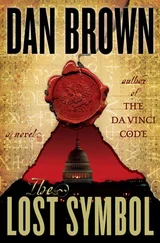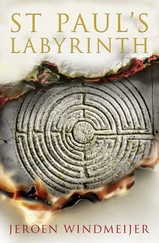Until a man is nothing, God can make nothing out of him. Martin Luther had spoken those words in the sixteenth century, but the concept had been part of the mind-set of builders since the earliest examples of religious architecture.
Langdon glanced over at Brüder and Sinskey, who had been staring upward and who now lowered their eyes to earth.
“Jesus,” Brüder said.
“Yes!” Mirsat said excitedly. “And Allah and Muhammad, too!”
Langdon chuckled as their guide directed Brüder’s gaze to the main altar, where a towering mosaic of Jesus was flanked by two massive disks bearing the Arabic names of Muhammad and Allah in ornate calligraphy.
“This museum,” Mirsat explained, “in an effort to remind visitors of the diverse uses of this sacred space, displays in tandem both the Christian iconography, from the days when Hagia Sophia was a basilica, and the Islamic iconography, from its days as a mosque.” He gave a proud smile. “Despite the friction between the religions in the real world, we think their symbols work quite nicely together. I know you agree, Professor.”
Langdon gave a heartfelt nod, recalling that all of the Christian iconography had been covered in whitewash when the building became a mosque. The restoration of the Christian symbols next to the Muslim symbols had created a mesmerizing effect, particularly because the styles and sensibilities of the two iconographies are polar opposites.
While Christian tradition favored literal images of its gods and saints, Islam focused on calligraphy and geometric patterns to represent the beauty of God’s universe. Islamic tradition held that only God could create life, and therefore man has no place creating images of life — not gods, not people, not even animals.
Langdon recalled once trying to explain this concept to his students: “A Muslim Michelangelo, for example, would never have painted God’s face on the ceiling of the Sistine Chapel; he would have inscribed the name of God. Depicting God’s face would be considered blasphemy.”
Langdon had gone on to explain the reason for this.
“Both Christianity and Islam are logocentric,” he told his students, “meaning they are focused on the Word. In Christian tradition, the Word became flesh in the book of John: ‘And the Word was made flesh, and He dwelt among us.’ Therefore, it was acceptable to depict the Word as having a human form. In Islamic tradition, however, the Word did not become flesh, and therefore the Word needs to remain in the form of a word … in most cases, calligraphic renderings of the names of the holy figures of Islam.”
One of Langdon’s students had summed up the complex history with an amusingly accurate marginal note: “Christians like faces; Muslims like words.”
“Here before us,” Mirsat went on, motioning across the spectacular room, “you see a unique blending of Christianity with Islam.”
He quickly pointed out the fusion of symbols in the massive apse, most notably the Virgin and Child gazing down upon a mihrab —the semicircular niche in a mosque that indicates the direction of Mecca. Nearby, a staircase rose up to an orator’s pulpit, which resembled the kind from which Christian sermons are delivered, but in fact was a minbar , the holy platform from which an imam leads Friday services. Similarly, the daislike structure nearby resembled a Christian choir stall but in reality was a müezzin mahfili , a raised platform where a muezzin kneels and chants in response to the imam’s prayers.
“Mosques and cathedrals are startlingly similar,” Mirsat proclaimed. “The traditions of East and West are not as divergent as you might think!”
“Mirsat?” Brüder pressed, sounding impatient. “We’d really like to see Dandolo’s tomb, if we may?”
Mirsat looked mildly annoyed, as if the man’s haste were somehow a display of disrespect to the building.
“Yes,” Langdon said. “I’m sorry to rush, but we’re on a very tight schedule.”
“Very well, then,” Mirsat said, pointing to a high balcony to their right. “Let’s head upstairs and see the tomb.”
“Up?” Langdon replied, startled. “Isn’t Enrico Dandolo buried down in the crypt?” Langdon recalled the tomb itself, but not the precise place in the building where it was located. He had been picturing the dark underground areas of the building.
Mirsat seemed confounded by the query. “No, Professor, the tomb of Enrico Dandolo is most certainly upstairs.”
* * *
What the devil is going on here? Mirsat wondered.
When Langdon had asked to see Dandolo’s tomb, Mirsat had sensed that the request was a kind of decoy. Nobody wants to see Dandolo’s tomb. Mirsat had assumed what Langdon really wanted to see was the enigmatic treasure directly beside Dandolo’s tomb — the Deesis Mosaic —an ancient Pantocrator Christ that was arguably one of the most mysterious pieces of art in the building.
Langdon is researching the mosaic, and trying to be discreet about it , Mirsat had guessed, imagining that the professor was probably writing a secret piece on the Deesis .
Now, however, Mirsat was confused. Certainly Langdon knew the Deesis Mosaic was on the second floor, so why was he acting so surprised?
Unless he is indeed looking for Dandolo’s tomb?
Puzzled, Mirsat guided them toward the staircase, passing one of Hagia Sophia’s two famous urns — a 330-gallon behemoth carved out of a single piece of marble during the Hellenistic period.
Climbing in silence now with his entourage, Mirsat found himself feeling unsettled. Langdon’s colleagues did not seem like academics at all. One of them looked like a soldier of some sort, muscular and rigid, dressed all in black. And the woman with the silver hair, Mirsat sensed … he had seen her before. Maybe on television?
He was starting to suspect that the purpose of this visit was not what it appeared to be. Why are they really here?
“One more flight,” Mirsat announced cheerily as they reached the landing. “Upstairs we shall find the tomb of Enrico Dandolo, and of course”—he paused, eyeing Langdon—“the famed Deesis Mosaic .”
Not even a flinch.
Langdon, it appeared, was not, in fact, here for the Deesis Mosaic at all. He and his guests seemed inexplicably fixated on Dandolo’s tomb.
As Mirsat led the way up the stairs, Langdon could tell that Brüder and Sinskey were worried. Admittedly, ascending to the second floor seemed to make no sense. Langdon kept picturing Zobrist’s subterranean video … and the documentary film about the submerged areas beneath Hagia Sophia.
We need to go down!
Even so, if this was the location of Dandolo’s tomb, they had no choice but to follow Zobrist’s directions. Kneel within the gilded mouseion of holy wisdom, and place thine ear to the ground, listening for the sounds of trickling water.
When they finally reached the second level, Mirsat led them to the right along the balcony’s edge, which offered breathtaking views of the sanctuary below. Langdon faced front, remaining focused.
Mirsat was talking fervently about the Deesis Mosaic again, but Langdon tuned him out.
He could now see his target.
Dandolo’s tomb.
The tomb appeared exactly as Langdon remembered it — a rectangular piece of white marble, inlaid in the polished stone floor and cordoned off by stanchions and chains.
Langdon rushed over and examined the carved inscription.
HENRICUS DANDOLO
As the others arrived behind him, Langdon sprang into action, stepping over the protective chain and placing his feet directly in front of the tombstone.
Читать дальше
Конец ознакомительного отрывка
Купить книгу










